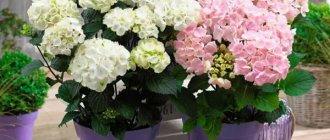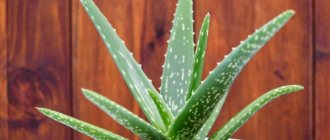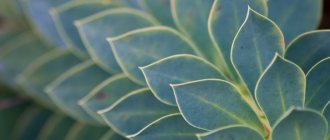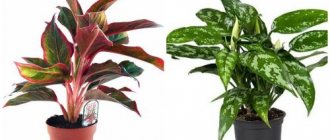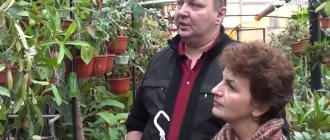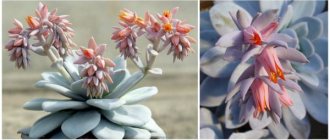Alocasia (in Latin - Alocasia) is a tropical plant native to South America, common in Eastern Australia, and appeared in Russia during the reign of Catherine II. The flower belongs to the aroid family and grows in open spaces, but can also be found in rocky areas.
Alocasia is called weatherweed and arum, and in alternative medicine - trefoil. This name is due to the fact that an adult plant rarely has more leaves. When the fourth one appears, the oldest leaf begins to dry out, and after a while it dies.
What does alocasia look like?
- The flower grows from 40 to 200 cm, has a strong and long stem directed vertically upward, sometimes creeping.
- The roots of alocasia are short and very thick, in the form of tubers.
- In the photo you can see that the plant has both one and three rounded leaves with a length of 20 to 90 cm. The foliage is colored emerald green, it may have reddish spots and yellowish-white veins.
- Alocasia fruits have the shape of an ellipse or an inverse cone; they can be split longitudinally. In the center of the fruit there are seeds (from 1 to 5 pieces).
The plant is distinguished by its beauty, which brings an element of exoticism to any room it occupies.
General information
The description of the flower includes many varieties and hybrids, but the main one grown as a houseplant is “Polly” or “Amazon” (A. amazonica).
Photos of Alocasia are impressive with stunning leaves that are shaped like an arrowhead or shield with large prominent white veins running through them, which contrasts greatly with the rest of the dark green leaf.
The most famous types and varieties of alocasia
Alocasia is represented by different species, each of which is beautiful in its own way and will take its rightful place among other plants. The most popular are:
- Alocasia amazonica is an Amazonian variety that does not produce fruit when grown at home:
- stems from 10 to 20 cm tall;
- petioles about half a meter;
- the leaves are elongated, 20 cm wide, dark green with white stripes.
Amazonian alocasia
- Alocasia cuprea is a copper-red species of plant, classified as not too large, decorative:
- the foliage is directed vertically upward, has the shape of an oval heart, about 20 cm wide and 30 cm long, its color is unusual: copper-green with a metallic sheen on top and rich purple below;
- the stem is not high, up to 10 cm;
- The flower stalks also have a purple tint, they are collected in 3 pieces.
Alocasia Cuprea
- Alocasia cucullata – hooded alocasia:
- it reaches a height of a meter, its stem has a diameter of 5 cm;
- petioles grow up to 80 cm;
- the foliage is quite dense and wide (about 80 cm), slightly pointed, has shades from dark to bright green;
- varieties with rich foliage bloom, and the inflorescence is quite high up to 30 cm.
Alocasia capulata
- Alocasia odora – odorous:
- the rhizome is very short and strong, tuberous;
- shoots stretch up to 1 meter in height;
- the foliage is very fleshy, 70 cm wide and about a meter long (young leaves look like a shield, and old ones look like arrows);
- the inflorescences of this species are cobs that have a specific aroma;
- The juice secreted by this type of alocasia is poisonous; you only need to work with the plant while wearing gloves.
Scented alocasia
- Black Velvet is a small type of alocasia (its stem reaches 25 cm):
- the foliage of the plant is velvety, oval-shaped, heart-shaped with a dark burgundy top and a pattern of veins;
- The peduncle grows up to 10 cm, its cover has a soft pink tint;
- does not produce inflorescences at home.
Alocasia Black Corduroy
- Alocasia Lowii - Low's alocasia, has underground root shoots and a short trunk:
- oval or arrow-shaped foliage is green with snow-white veins, they are purple on the inside;
- The petioles of the foliage are quite long.
Alocasia Lowe
Alocasia Sandera
The Filipino guest is quite often found on the windowsills of our country. Sandera has some characteristic features:
- very short stems, substantial and thick;
- petioles somewhat elongated;
- the foliage is large, up to 40 cm long, about 15 cm wide;
- the foliage has an arrow shape and wavy edges;
- leaves have color variations from soft olive to deep green, with obligatory veins of light shades;
- Sandera's flowers are rather inconspicuous; after they disappear, bright orange fruits appear.
Sandera is especially active in the warm season, but in winter she has time to rest. During this period, you should not actively water the plant; it is better to spray it periodically. When placing a flower, you should take into account its love for wide space and provide it with maximum freedom.
Alocasia Sandera
This medicinal species is also called large-rhizome. In the wild, it can grow up to 3 meters in height; at home, the flower’s reach is somewhat weaker. The homeland of this alocasia is Sri Lanka; local residents use the leaves of the plant as umbrellas, they are so large.
Plant characteristics:
- stems more than 2 meters long;
- petioles have a height of 1 meter;
- the foliage is heart-shaped, with brightly defined lobes diverging in the middle of its plate;
- The peduncle is large, grows up to 30 cm;
- the berries are quite large, red, more than a centimeter in diameter;
- The juice of the plant is poisonous, but it is actively used in alternative medicine.
Plant characteristics
Belongs to the Araceae family, which today unites about 70 species. Alocasia is an evergreen large-leaved plant that has the following features depending on the species:
- Has a stem or stemless.
- Grows from 30-40 cm to 2 meters in height.
- The shapes of the dense leaf plates are oval, thyroid, heart-shaped, up to a meter in length.
- The root system is of the tuberous type.
Alocasia variety Black corduroy
Attention! Alocasia is a flower that contains poison; it is unacceptable for its juice to come into contact with open areas of the body and mucous membranes.
Work with the plant must be carried out in compliance with safety regulations; its placement must be inaccessible to children and pets.
In nature, after heavy tropical downpours, at home, with excessive watering, alocasia leaves begin to secrete droplets of water.
Alocasia domestica is a plant used to treat many diseases. Therapy is carried out using alcohol tinctures of certain varieties of the culture. Its magical properties have long been used in Chinese folk medicine. The phytoncides of the flower perfectly purify the air in the room.
How often does alocasia bloom?
To see alocasia bloom, you need to create special conditions for it with high tropical humidity. In modern apartments this is not an easy task. Some plants of this species are occasionally capable of throwing out the inflorescence, while others will never bloom.
In general, alocasia that has reached the age of 7 years is capable of blooming. Most often, inflorescences appear in pairs with a new leaf, replacing the old one that falls off. The flower is covered with a kind of blanket that wraps it in a cocoon; after the seeds ripen, it gradually disappears.
The weatherflower flower has a rather strong aroma. Its flowering period falls in the summer, when the plant receives sufficient light and moisture. Moreover, it is not constant watering, but a slight drought that can stimulate alocasia to bloom.
Interesting fact: the plant is not able to nourish both foliage and flower at the same time. Therefore, the owner must choose what he likes to admire more: the blooming crown or lush foliage. It is worth noting that after the end of the flowering period, alocasia rests for 3 months.
Alocasia flowering
What to do after the plant has bloomed
The flowering of alocasia takes a lot of energy from the plant, after which the plant necessarily loses one or more leaves. During this period, the trunk is exposed. Most often, the owners prefer to remove the peduncle, which is not very beautiful, but can destroy the rich foliage. It is important to remember: it is not the bud that needs to be removed, but the peduncle itself as soon as it begins to appear, without waiting for the plant to become exhausted.
When the inflorescence is removed or the flowering period is over, it is necessary to feed the plant with a complex of fertilizers, both mineral and organic.
Optimal time for planting
Alocasia should be planted in permanent soil immediately after purchasing it in a store.
You need to plant alocasia in a pot like this:
- The roots of the plant must be cleaned of soil and carefully inspected, identifying those that are dried out and rotten. The latter need to be removed.
- Alocasia roots need to be washed from the substrate and soaked for half an hour in a nutrient solution to improve the adaptive process of the plant.
- Now the flower needs to be placed in a previously prepared pot and filled with new soil. The root collar remains half-open, located at the very border of the soil.
The ideal time for planting alocasia is considered to be spring, when the plant enters the active growth phase. During the summer, the plant will have time to settle into its new location and will survive the winter well. However, if the plant was purchased in the autumn-winter period, it can and should also be planted in a pot. Only the adaptive period in this case takes a little longer.
Possible problems in growing
Alocasia has no fewer diseases than other flowers. Leaves can signal this.
Leaves turn yellow
How to treat if the leaf begins to turn yellow? Leaves may change color for the following reasons:
- yellowness around the edges – poor water composition;
- the entire leaf has changed color - lack of nutrition or a sign of aging.
Old leaves are cut off after drying.
The tips of the leaves are drying out
This is a sign of necrosis infection. Draft, violation of temperature conditions, stagnation of moisture in the pot lead to such a problem.
The lower leaves fall off
This happens when the flower is cramped in the pot, there is a lack of nutrients, or pests have appeared.
Pests
Alocasia has a big enemy - the spider mite. Invisible to the naked eye, it lays larvae on the bottom of the leaf. White cobwebs and red dots are sure signs of a pest.
Proper plant care and pest control will help alocasia take its rightful place in the house. If you take care of it, the plant will bloom and not only decorate the interior, but also create a healthy microclimate throughout the room.
Soil selection, feeding and fertilizing alocasia
The ideal composition for growing alocasia will be one of the following:
- special soil with the inclusion of disintegrants (charcoal, sand or perlite);
- mixture for coniferous soil and birch coal;
- the presence of sphagnum and moss in the soil for alocasia is important;
- a good composition includes: garden soil, peat, orchid mixture, perlite and sphagnum, which is finely chopped;
- the plant behaves well in soil with the following composition: pine soil, high peat, sphagnum;
- a mixture of peat and soil from a greenhouse.
Most species of this plant love slightly acidic soil, and copper-red alocasia only accepts a substrate containing dolomite flour or lime. In addition, it is important to organize drainage at the bottom of the pot; its thickness should not be less than 2 cm.
Principles of fertilizing alocasia:
- In the summer, fertilizers are applied once every two weeks, and it is better to dilute the dose so as not to overload the plant with excess salt content.
- In winter, fertilizing is carried out once a month.
- Alocasia tolerates Agricola and Belvito fertilizers well.
- Fertilizing with bird droppings, which is diluted with water in a ratio of 1 to 30 and left for 5 days, helps the growth of the flower well.
- You can also use surface fertilizers for foliage. They should be less concentrated to prevent burning of the leaf plates.
There is also an opinion that there is no need to fertilize and feed alocasia. It is enough to replant it in fresh soil once a year.
Reviews about growing
Advantages: very beautiful ornamental plant.
Disadvantages: poisonous. I’ve been wanting to buy Alocasia for a long time, but then my husband brought me a shoot from work. Of course, I was pleased and planted it in a beautiful pot. It hasn't grown at all for a very long time, only now, in the spring, it started. What attracts me most about it is the unusual shape and decorative dark green color of the leaves, with bright white veins. This is what I have, and there are also ones with red or purple veins. Of course, since the plant is very poisonous, it should be kept away from children. Alocasia should be watered quite often as the soil dries out, and fertilized during the period of active growth. I fertilize once a month with complex fertilizer. helen-vay
https://otzovik.com/review_933443.html
Pros: handsome!
Disadvantages: capricious, does not take root well in our conditions. Oh, this Alocasia Polly. I bought it in winter. I replanted it in new soil for alocasia, added vermiculite, and finely chopped sphagnum. Added drainage to the bottom. Just a couple of days later, yellow spots appeared on the leaves, then the leaves themselves began to turn yellow. I dug it up and discovered that the bulb and roots had begun to rot. No matter how I tried to revive the bulb, nothing worked. Later I read that alocasia is very prone to rotting bulbs, you need to be careful with watering. Tim82
https://irecommend.ru/content/alokaziya-polli
Alocasia was given to me for my birthday at work.
There were 2 leaves))) Now the beauty has grown, she even wants to bloom! I don’t make any special efforts to grow it, I just don’t put it in the sun and try not to overwater it. Tatiyanna77
https://irecommend.ru/users/tatiyanna77
Lighting alocasia flowers
There has long been a widespread misconception that alocasia is shade-loving. This is not true, the plant respects bright light, which should be slightly diffused. This especially applies to those varieties that have variegated colors. If you keep alocasia in the shade, its foliage will become monochromatic and faded. New leaves will not grow large, and the weakened flower may dry out.
Installing the plant on a sunny windowsill would also be the wrong decision. The ideal option would be to create artificial shade using blinds or to grow alocasia in the east or west; the southern part is unlikely to be suitable. A window sill facing north can also be a good place for this flower to live. It is important, if necessary, to use artificial lighting, especially in winter, when daylight hours are already quite short.
The whims of a tropical woman
This lady belongs to the decorative leaf group.
Growing a green friend in an apartment garden is not difficult if you remember a few rules.
Take care of it, observing safety precautions, keep it away from animals and children.
She loves bright, diffused light, and it is recommended to place the flowerpot on east and west windows. It is also possible to place it on the south side, only with shading.
The beauty's homeland is the tropics. The high humidity of the forests of Ceylon, China and Malaysia creates an ideal habitat for the greenhouse miracle.
But in a temperate climate it is not easy to create suitable conditions for it. But probably. In the hot season, favorable conditions for it are at an air temperature of 24-26 degrees. In cold weather, during the rest period, 15-18 above zero is enough.
Spray only with warm water, otherwise unsightly spots will appear. In the cold season, do not spray, but wipe the leaves with a dampened sponge.
Also, for the desired microclimate, place a pot with capricious plants in a container with pebbles, which will contain water. On particularly hot days, it is recommended to put a few pieces of ice on the pebbles.
Temperature, air humidity and watering of alocasia
Undoubtedly, a guest from the tropical forests needs to be watered frequently and abundantly. The following principles for organizing watering and air humidification for this plant can be noted:
- not all varieties can be sprayed (this applies to “Black Velvet” and “Royal Alocasia”); for them, wetting the leaves on their lower part through the small holes of a watering can is suitable;
- Installing trays under pots that will be filled with wet expanded clay helps a lot in maintaining the required level of moisture;
- From time to time you can take the flowers into the bath and give them a shower at room temperature;
- Lightly moistened sphagnum should be placed around the stem and the soil should be mulched;
- it is important to ensure regular ventilation of the room to prevent stagnant air, which can become an excellent place for the development of fungal infections;
- the optimal air temperature will be 20–25 degrees, occasionally you can drop it to 16 degrees;
- it is very important to prevent waterlogging of the soil and remove water from the trays in a timely manner;
- Alocasia does not like cold air flows from air conditioners, and at the height of summer it will definitely appreciate additional spraying.
Separately, it is necessary to note the difference in watering depending on the season:
- In the spring and summer, an active vegetation process occurs: the soil must be watered as soon as its top layer dries out.
- In autumn and winter, the soil requires watering no more than twice a week.
Popular questions and answers
Irina Zilbelvarg, Candidate of Biological Sciences, Associate Professor of the Department of Ornamental Plant Growing, answered the most pressing questions from flower growers about caring for alocasia
How to choose alocasia?
When choosing alocasia in the store, pay attention to whether the root system is flooded, whether there are black dots and brown spots on the leaves, or whether the leaves are pale. Most often, alocasia has 3 - 4 main leaves; it’s good if they are sufficiently developed, no more are needed. The soil should be moist, but there should not be any putrid odor from the pot, and water should not squelch in it.
What kind of pot is needed for alocasia?
You need to choose a pot that is tall and not too large - alocasia does not like spacious containers.
Does Alocasia bloom?
The plant can bloom and form an inflorescence spadix, somewhat similar to the inflorescence of a calla lily, only less decorative. However, at home, flowering is rare.
Why does alocasia turn yellow?
These could be various diseases, improper watering and air humidity, unsuitable soil, or natural aging. Alocasia requires high air humidity - from 70 to 90%. They feel great near bodies of water, for example, next to an aquarium.
Why do spots appear on alocasia?
Most likely these are fungal infections, and they appear from excess moisture.
Is it possible to grow alocasia indoors?
Since the plant is poisonous, I would not recommend having it for those who have small children and animals.
For example, cats very often try to taste indoor plants and can become poisoned. Sources
- Grudzinskaya I.A. Arum family (Araceae) / Plant life. In 6 volumes. T. 6. Flowering plants / Under. ed. Takhtajyan A.L. // M.: Education, 1982
- Tulintsev V.G. Floriculture with the basics of selection and seed production // Stroyizdat, Leningrad branch, 1977 - 208 p.
- State catalog of pesticides and agrochemicals approved for use on the territory of the Russian Federation as of July 6, 2022 // Ministry of Agriculture of the Russian Federation https://mcx.gov.ru/ministry/departments/departament-rastenievodstva-mekhanizatsii-khimizatsii- i-zashchity-rasteniy/industry-information/info-gosudarstvennaya-usluga-po-gosudarstvennoy-registratsii-pestitsidov-i-agrokhimikatov/
Plant care at different times of the year
| Season | Lighting | Air temperature | Fertilizer | Transfer |
| Spring | At any time, the flower will appreciate soft, diffused light. The shade can lead to the death of the plant, and too bright sunlight can burn the foliage. This is especially important for alocasia with leaves of bright colors. | During this period, the plant is comfortable at 20–26 degrees | From April to October, nitrogen and other mineral-based supplements should be applied. The benefits from them will be maximum | Held annually in spring or early summer |
| Summer | ||||
| Autumn | 17–20 degrees is enough, occasionally you can lower the temperature to 16 degrees | The soil fertilization process is suspended | Not carried out. At this time, the plant is resting, and it is not recommended to replant it | |
| Winter |
Problems with Alocasia plants
Spider Mites / Scales / Mealybugs / Aphids - Alocasia is poisonous to humans, cats, dogs, etc., but is quite tasty and makes a good home for a variety of pests! Most of them can be eliminated by maintaining high humidity.
Brown leaves with yellow markings – If the leaves have yellow spots, it is likely due to one of the following:
Excessive watering. You can let the soil dry out a bit, but aim for moist, but never soggy, soil.
The plant or soil is too cold. The whole plant, even the roots, likes to be cozy. Keep it in a warm area and when watering make sure the water is not ice cold as this will cool the soil.
Dry, crispy alocasia leaves - This is usually a sign that the humidity around the plant is too low. They love warm places in your home, but they also need a certain level of humidity in the air. Some people suggest misting the plant, which will probably help in the short term, but you need to do it daily. If this is too much work, try some of the more traditional ways to achieve this for a more permanent solution.
Pale, mottled brown leaves – Leaves that are too light are usually caused by direct sunlight or the plant moving too quickly from a dark location to a very bright one.
My plant is wilting - If the plant has been healthy all year but everything dies back in the winter, your plant is likely entering a normal dying dormant period. This means that everything above the ground dies off. Continue tending to what will look like an empty pot because the rhizomes underground will still be alive. Growth will resume in spring.
If at any other time of the year the plant dies, then, unfortunately, you have not been able to adapt to its fussy nature. If you notice this early enough, it is not too late, try to create the conditions described in the care information above.
Features of caring for Alocasia Polly
Alocasia Polly or Amazonica will definitely delight the owner with a wealth of lush greenery, if you manage to choose the right soil and ensure proper organization of watering the plant.
The plant will appreciate this indoor soil:
- air- and moisture-permeable;
- no fluid retention;
- ideal composition: peat, garden soil and mixture for growing orchids;
- There must be expanded clay or a small amount of pebbles in the tray under the pot, which must be periodically moistened with water.
Watering Alocasia Polly is very important; the soil should not dry out or, conversely, be too wet. The ideal option would be to water the plant with water that is at room temperature and pre-settled (ideally, boiled).
In summer or spring, all alocasia greens should be periodically sprinkled with water at room temperature; in winter, you can simply wipe the foliage with a soft, slightly moistened cloth. It is worth noting that exposure to a large amount of sunlight can cause Polly to turn yellow. In this case, it is important to increase the intensity of watering.
If polly begins to turn yellow and lose leaves, this may be evidence of a lack of water and light, and perhaps heat. It is important to optimize the care of the plant so that the flower will quickly resume its development and stop fading.
The most common problems and their causes
Many problems with growing alocasia are caused by care errors:
- Slow growth. This indicates a lack of nitrogen in the soil. Feed the flower with a urea solution (1 g of substance per 1 liter of water).
- Drying and wilting of leaves. The reason for this is the water used for irrigation. Most likely, it contains large amounts of iron, chlorine and salts. The soil should be replaced and the plant should be watered with the settled liquid.
- The color of the leaves has become pale. Alocasia needs more sunlight. In winter, fluorescent lamps can be used as additional lighting.
- Dark spots appear on the leaves. This occurs due to sudden temperature changes and drafts.
- The leaves began to rot. The plant is affected by root rot. Alocasia should be treated with Fundozol solution and transplanted into looser soil.
Transplantation and propagation of alocasia
It is advisable to replant alocasia 1–2 times a year. As a rule, a young plant can grow out of its pot in just 4 months, so it will have to be replanted twice a year. But a mature alocasia can be replanted after a year in order to give it more nutrients with new soil.
Breeding alocasia goes like this:
- You need to shake off the soil from the roots;
- tubers found among the roots can be planted separately;
- to obtain adventitious shoots, you can slightly deepen the roots of the plant;
- you need to replant the flower in a pot that is wider than the original one, and be sure to put expanded clay drainage on the bottom.
Rhizome division
Alocasia can be propagated by dividing its rhizomes. It is important to remember that this method must be combined with the annual replacement of the plant’s soil (from late March to early May).
Reproduction by dividing the rhizome is done as follows:
- first you need to carefully remove the soil without damaging the rhizomes;
- if the soil is compacted, you can moisten it a little under running water;
- Now you need to divide the rhizomes with a knife, be sure to leave a growth bud or rosette with foliage on each part;
- now the place where the rhizome was cut needs to be sprinkled with charcoal dust and left for 1 hour to dry completely;
- when the cut dries, it is transplanted into prepared soil and watered abundantly;
- now it is enough to maintain the air temperature at 24 degrees and regularly spray the plant; during this period you need to keep alocasia away from sunlight.
Tuber planting
In the spring, when tubers appear on the surface of the soil, they can be transplanted. It is not uncommon for tubers to begin to grow directly in the pot with the flower from which they came. In this case, careful separation of the tuber from the mature plant is required.
After this, the tubers need to be germinated; sphagnum moss will help for this purpose; it should be regularly moistened, preventing changes in the ambient temperature and maintaining it within 22–24 degrees. You can put a plastic bag over the pot with the germinating tubers to create the maximum level of humidity.
After the tuber germinates and the leaf peeking out from it unfolds, the young plant can be transplanted into the soil. You can start feeding this plant with fertilizers and minerals immediately after at least three leaves appear.
Using cuttings
Those varieties of alocasia that are decorated with emerald foliage can easily be propagated by cuttings. To do this, the following manipulations are carried out:
- The top of the shoot is cut with a knife at an angle of 45 degrees.
- Before planting the cutting, you need to treat it with a special product to stimulate growth (for example, “Novinka”).
- Now the cuttings can be planted in the soil prepared in a pot and watered generously with warm water.
- For better growth of alocasia, you need to create the most comfortable conditions for it:
- air temperature at 23 degrees;
- regular watering and spraying;
- no drafts.
It is important to remember that all work with alocasia should be carried out wearing protective gloves. At the same time, avoid allowing the plant juice to come into contact with the skin of the hands, face or mucous membranes.
Reproduction methods
Growing from seeds
Flower growers grow from seeds only those species and varieties of alocasia whose foliage has a uniform color. When growing variegated forms from seeds, there is a high probability that the emerging seedlings will not retain the varietal characteristics of the mother plant. Fill the container with a soil mixture consisting of peat and sand (1:1), the seeds are distributed over its surface and only slightly pressed into the substrate. The crops are covered with film (glass) on top and placed in a warm (about 24 degrees) place. Provide the crops with regular watering and ventilation. The emerging seedlings, after they have grown stronger, dive into separate pots. And when the plants grow up, they are planted again in pots up to 70 mm in diameter. After the root system of a young plant becomes very crowded, it is transferred to a larger pot and begins to be cared for as an adult flower.
Vegetative propagation
Alocasia can be propagated from various parts of the bush. However, no matter which part you choose, the cut points on the rhizome or cuttings must be treated with crushed charcoal. For rooting, they are planted in a substrate containing peat and sand (1:1). The container in which part of the bush was planted should be covered on top with a film, bag or glass; it should be provided with systematic watering and ventilation. In order for rooting to be successful, the air temperature should be maintained at a level of 22 to 24 degrees. When the first shoots appear, the bush is transplanted into a temporary container, and after it gets stronger and its roots grow, it is transferred to a permanent pot.
Alocasia: propagation and resuscitation of a discounted plant. Part 1
Plant pests and diseases
Alocasia, like other indoor plants, is not without problems with the occurrence of pests or diseases. To preserve the plant, you need to take timely measures to eliminate these problems.
What to do if problems appear with the plant?
Alocasia is not a very capricious flower, however, it does have some problems:
- The plant loses its growth rate: lack of nitrogen fertilizers, which can be compensated for with an aqueous solution of urea.
- Foliage withers: the soil is either too dry or waterlogged. In this case, you need to adjust the watering regime and, if necessary, replace the substrate in the tray.
- The color of the leaves turns pale: the flower lacks light, which can be increased by adding artificial lighting.
- The tips of the foliage dry out and turn brown: the air in the room is too dry or the plant does not have enough water. It is necessary to carry out regular spraying and watering with warm water.
- The leaves begin to rot: the plant is infected with root rot. It needs to be treated with an antifungal agent (“Fundozol”), the leaves that have rotted are removed. The plant itself requires transplantation into a substrate of a looser consistency.
Signs of infestation and pests
Alocasia is susceptible to infection by the following diseases and pests:
- Scale appears due to excessive moisture of the plant: the foliage of alocasia is covered with dark spots that also cover the stem of the plant. You can get rid of scale insects by spraying the flower with a solution of tobacco and soap mixed with kerosene. Pests should be removed with a cotton pad soaked in this solution.
- Aphids settle on the lower surface of leaves, which can cause them to curl and dry out. The flower must be treated with a special anti-aphid agent; after a day, the alocasia is washed and re-treated.
- A sign of a flower being damaged by a mealybug is the appearance of a whitish fluff and a stop in the growth of alocasia. The plant is treated with an alcohol solution, carefully wiping the foliage and stems.
How to deal with spider mites
The appearance of a small red spider should alert the owner; it could be a spider mite. It can cause alocasia a lot of trouble, including yellowing of the foliage.
You can get rid of spider mites by spraying the leaves with insecticides, followed by washing them with warm water. It is important to carefully treat the lower surface of the foliage, carefully removing all cobwebs.
Remedies for spider mites:
- tobacco infusion;
- pollination with store-bought insecticides (carried out only outdoors);
- ground sulfur;
- water.
Possible difficulties
When growing alocasia, you should pay attention to the following difficulties that gardeners usually encounter when growing this plant:
- Alocasia has stopped growing. This situation arises for two reasons: either the plant needs replanting or is experiencing a deficiency of minerals. The solution here is very simple; the flower needs to be transplanted into a larger pot or, if the container is normal for the plant, fed.
Alocasia diseases - Alocasia leaves wither. This problem occurs when the soil is excessively waterlogged. It can also occur when the earthen lump is very dry. In this case, it is enough to adjust the watering. If, even after normal watering, the leaves continue to wither, it means that the soil in the pot is too dense. In this case, you should change the soil to a looser and more breathable one.
- Alocasia leaves have turned pale or changed color. This situation occurs with aging and dying leaves. In place of the old fallen leaves, after a certain period of time, new leaves grow. The drawing on the sheet may fade due to lack of light.
- The tips of the leaves dry out and turn black. The reason is lack of watering, low light, low air humidity.
- Dark spots have appeared on the leaves of Alocasia. There may be several reasons: drafts, hypothermia, too dry or vice versa, damp soil, overdose of fertilizers. Dark spots sometimes appear due to mechanical damage, waterlogging of the soil and excessive application of nitrogen fertilizers. This situation often leads to the occurrence of fungal and bacterial rot. In this case, the rotten place is treated with fungicides or the plant is transplanted into new soil.
- Rotting of the rhizome. This problem occurs when the room temperature is low, there are drafts, and the plant is flooded so that the soil does not have time to dry.
Medicinal properties of alocasia
The characteristics of alocasia indicate that this medicinal plant, pleasing to the eye with its flowering, however, can cause many problems. The thing is that the plant contains poison (mercuric chloride and cyanide), and in all its parts. Therefore, it is important to carry out all actions carried out with alocasia only with protective gloves, preventing the poison from getting on the mucous membranes and skin. You cannot die from exposure to the poison, but you can get quite noticeable burns. If there are children and animals in the house, you should think about the need to purchase alocasia.
This odorous, poisonous flower, which is dangerous in essence, has beneficial contents. That is why its cultivation is so widespread in the East. The medicinal properties of the plant allow it to be quite successfully used in the treatment of such diseases:
- pneumonia;
- tuberculosis;
- joint diseases;
- streptococcus and Escherichia coli;
- oncological diseases;
- gastrointestinal problems;
- flu;
- cardiovascular diseases.
Alocasia spreads phytoncides around itself and has a bactericidal effect on the air, which, together with the splendor of its emerald foliage, makes it a popular inhabitant of indoor greenhouses.

